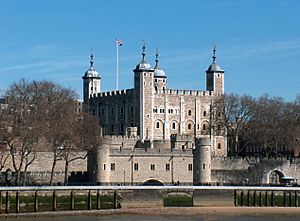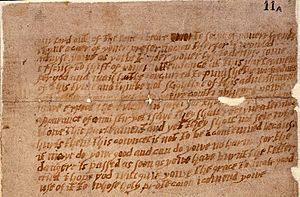Francis Tresham facts for kids
Quick facts for kids
Francis Tresham
|
|
|---|---|
| Born | c. 1567 |
| Died | 23 December 1605 (aged 37–38) |
| Cause of death | Strangury |
| Spouse(s) | Anne Tufton |
| Children | Lucy, Thomas, Elizabeth |
| Parent(s) | Sir Thomas Tresham, Meriel Throckmorton |
| Motive | Gunpowder plot, a conspiracy to assassinate King James VI & I and members of the Houses of Parliament |
| Role | Funding |
| Enlisted | 14 October 1605 |
Francis Tresham (around 1567 – 23 December 1605) was an English Catholic. He was the oldest son of Thomas Tresham and Muriel Throckmorton. Francis Tresham was part of the group that planned the Gunpowder Plot in 1605. This was a secret plan to kill King James I of England and members of Parliament.
Tresham had been in trouble before. In 1601, he joined a failed rebellion led by the Earl of Essex. He was put in prison for this. His family and his father's money saved him from being punished even more. Even after this, he got involved in secret trips to Catholic Spain. He wanted to find support for English Catholics, who were treated very badly at the time. Finally, he joined the Gunpowder Plotters.
Tresham joined the plot in October 1605. The leader, Robert Catesby, asked him for a lot of money and the use of Rushton Hall. But Tresham did not give much money. He gave a smaller amount to another plotter, Thomas Wintour. Tresham was also worried that two of his brothers-in-law would die if the plot succeeded. An anonymous letter was sent to one of them, William Parker, 4th Baron Monteagle. This letter reached the English Secretary of State, Robert Cecil. This event was very important in stopping the plot.
Many historians think Tresham wrote the letter, but this is not proven. Catesby and Wintour also suspected him and threatened to kill him. But Tresham convinced them he was innocent. He was arrested on 12 November and held in the Tower of London. In his confession, he tried to make his role in the plot seem small. He never mentioned the letter. He died naturally on 23 December 1605.
Contents
Early Life and Family Connections
Francis Tresham was born around 1567. He was the oldest son of Sir Thomas Tresham from Rushton Hall in Northamptonshire. His mother was Meriel Throckmorton. She was the daughter of Sir Robert Throckmorton from Coughton in Warwickshire. Some say Tresham studied at Oxford University, but there is no strong proof.
Francis was said to be a prisoner with Robert Catesby in Wisbech Castle. This was around the time of the Spanish Armada.
In 1593, he married Anne Tufton. She was the daughter of Sir John Tufton. They had three children: twins Lucy and Thomas (born 1598), and Elizabeth. Thomas died when he was a baby. Lucy became a nun, and Elizabeth married Sir George Heneage.
Francis's father, Thomas Tresham, was a leader among Catholics. He faced many fines and prison stays for his Catholic faith. He supported King James I when he became king. But James did not keep his promises to help Thomas. His father's money was greatly reduced by fines and spending on his daughters' weddings. When he died in 1605, he was in debt.
Francis Tresham was known for being a bit wild. He was also said to spend his father's money freely. A Jesuit priest named Oswald Tesimond said Tresham was "a man of sound judgement." But he also said Tresham "was not much to be trusted."
On 8 February 1601, Tresham joined the Earl of Essex's rebellion against the government. This rebellion failed. Tresham was captured and put in prison. His family worked hard to help him. He was released on 21 June. He had to pay a large sum of money. This experience did not stop him from getting involved in more secret plans. In 1602 and 1603, he helped with trips to Catholic Spain. These trips were to get support for English Catholics. The English government called this the Spanish Treason.
His father tried to get him a job as a deer park keeper. But villagers in Brigstock did not want him. They did not like that the Tresham family were Catholics. Catholics gathered at a lodge in Brigstock at night.
The Gunpowder Plot Begins
English Catholics hoped that King James I would be kinder to them than Queen Elizabeth I. But Robert Catesby, a very religious Catholic, grew tired of James's actions. Catesby decided to kill the king. He planned to blow up the House of Lords with gunpowder. Then, he hoped to start a revolt and make James's daughter, Princess Elizabeth, the new Queen.
Catesby had already gathered 11 other Catholics for his plan. But he was running out of money. Even with his father's debts, Tresham was one of the richest people the plotters knew. He had a yearly income of over £3,000. Catesby's mother was Tresham's aunt. The two cousins had grown up together and were close.
The plotters did not tell Tresham about the plan until 14 October 1605. This was shortly after his father died. It was also just weeks before the explosion was planned. Tresham said the meeting happened at his brother-in-law's home. Tresham claimed he asked Catesby if the plot was "damnable" (morally wrong). Catesby said it was not. Tresham then pointed out the danger all Catholics would face if the plot succeeded. Catesby replied that it "must needs be done" because of "The necessity of the Catholics."
Catesby wanted two things from Tresham: £2,000 and the use of Rushton Hall. Tresham gave him neither. He had no money to spare because of his father's debts. But he did pay a small amount to Thomas Wintour. He thought Wintour was traveling to the Low Countries. After the meeting, Tresham went back to Rushton Hall. He closed his household and hid family papers. He then returned to London with his mother and sisters. On 2 November, he got permission to travel abroad.
The Monteagle Letter
Later in October, the plotters talked about what would happen to important Catholic lords. Tresham was most worried about his two brothers-in-law, William Parker, 4th Baron Monteagle, and Edward Stourton, 10th Baron Stourton. But Catesby said that "the innocent must perish with the guilty." He said this was better than ruining the plot's success.
On Saturday 26 October, Monteagle received a secret letter at his house. It said:
My Lord, out of the love I bear to some of your friends, I have a care of your preservation. Therefore I would advise you, as you tender your life, to devise some excuse to shift your attendance at this parliament; for God and man hath concurred to punish the wickedness of this time. And think not slightly of this advertisement, but retire yourself into your country where you may expect the event in safety. For though there be no appearance of any stir, yet I say they shall receive a terrible blow this Parliament; and yet they shall not see who hurts them. This counsel is not to be condemned because it may do you good and can do you no harm; for the danger is passed as soon as you have burnt the letter. And I hope God will give you the grace to make good use of it, to whose holy protection I commend you.
Monteagle did not understand the letter. He gave it to the English Secretary of State, Robert Cecil.
Many people have long thought Tresham wrote this letter. Historian Mark Nicholls believes he almost certainly did. When Catesby found out about the letter, he immediately suspected Tresham. He went with Thomas Wintour to confront him. They threatened to "hang him." But Tresham convinced them he was innocent. The next day, he wrote to them, urging them to stop the plot. Historian Antonia Fraser says Catesby and Wintour's decision to believe him should be considered. When Tresham was dying in the Tower of London, he did not mention the letter. Fraser thinks this makes no sense if he wrote it. Especially since the letter's receiver was seen as the country's hero.
The Plot is Discovered
Cecil already knew something was happening, even before the letter. But he did not know exactly what the plot was or who was involved. He decided to wait and watch. When Monteagle's letter was shown to the king on Friday 1 November, James thought it hinted at "fire and powder." He thought it might be an explosion like the one that killed his father in 1567. The next day, the King's advisors decided to search the Houses of Parliament.
Meanwhile, Tresham again told Catesby and Wintour to stop the plan. But they did not listen. Another plotter, Thomas Percy, said he was ready to face anything. On 4 November, Catesby and others left London. They went to the Midlands to get ready for their planned uprising.
Guy Fawkes was arrested while guarding the explosives. This happened shortly after midnight on 5 November 1605. He first called himself John Johnson. On 6 November, King James ordered that "John Johnson" be tortured. Finally, he gave in. On 7 November, he told his real name. On 8 November, he started naming some of the people he was working with.
Tresham's involvement was not revealed until the next day. He was only said to have a small role. But while his friends had run away from London, Tresham had stayed. He was arrested on 12 November. Three days later, he was moved to the Tower of London. Catesby and several other plotters were killed on 8 November. This happened during a fight at Holbeche House in Staffordshire.
Tresham's Death

At first, Tresham did not want to talk. But on 13 November, he confessed to being involved in the plot. He told his story to the people questioning him. He said moving his family from Rushton showed he did not believe he was taking them into danger. He told the government he was only guilty of keeping the plot a secret. He denied being an active member of the conspiracy. But by the end of the month, he also admitted his part in the Spanish Treason of 1602–1603. He claimed he had convinced Thomas Wintour and Thomas Percy to delay the explosion. He also said he planned to tell the king's secretary about a "Puritan conspiracy." Historian Antonia Fraser believes much of his confession was "highly partial." She says he was trying to protect himself, his wife, and his children. This shows he was not always reliable.
Tresham suffered from a painful urinary tract condition called strangury. In December 1605, his health got worse. The Lieutenant of the Tower, William Waad, wondered if Tresham would live long enough for a trial. Tresham preferred a Dr Richard Foster over the Tower's usual doctor. This suggests Foster had treated him before. During his last days, he had three doctors and a nurse. William Vavasour, possibly Tresham's half-brother, was also there. Tresham's wife, Anne, was too upset to write. So Vavasour wrote Tresham's dying confession and an account of his last hours.
Tresham apologized to the Jesuit priest Henry Garnet. He had wrongly involved Garnet in the Spanish Treason. He used the rest of his confession to say he was innocent. Anne and William read prayers by his bed. He died at 2:00 am on 23 December. Even though he was not tried, his head was displayed in Northampton. This was with the heads of Catesby and Percy. His body was thrown into a hole at Tower Hill. His lands went to his brother Lewis. Tresham's apology never reached Garnet. Tresham's letter and a book by Garnet were found in Tresham's room. These were used against Garnet in his trial. The priest was executed in May 1606.
|



